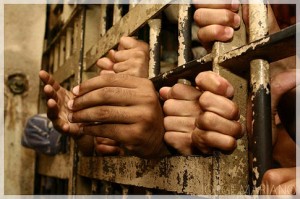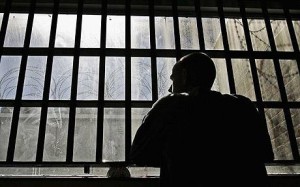Going to school with different types of people, I have been exposed to different lifestyles and many different opportunities. With race being a descriptive difference between the environments I have grown up in and learned from, I am aware of the different conditions within these environments. There is a complex racial dynamic in our society and it is strengthened and buoyed, on a micro level, by our justice system, but on a macro level, by a need for bodies to fill our prisons. In my personal observations the justice system has completely different roles in white communities than in communities of color. The reason is evident in the answer to the question: Who populates  these prisons? While black people make up only 13.1% of America’s population, they make up a over one-third of our prison population and Latinos make up around 20% of the prison population.
these prisons? While black people make up only 13.1% of America’s population, they make up a over one-third of our prison population and Latinos make up around 20% of the prison population.
Riding around with friends who are white, I see that they are not fearful of the law. To put it simply, they are able to get away with a lot more. Meanwhile, when with my black male friends in particular, simply passing a police officer on the sidewalk is a stressful ordeal, whether doing good or bad. There is widespread knowledge in black communities of the unjust mass incarceration of people of color. The motive behind this mass incarceration lies in the desire for profit instead of rehabilitation of criminals ; and the result is the creation of an underrepresented, marginalized and deprived caste of people living in one of the most modern and liberal Nations in the world,
Although people of color are a minority in America, it is clear that mass incarceration has ominously favored a few races over all the others. The combined demographics of Hispanics and Blacks are 58% of the prison population. And an astounding 1 million African Americans account for the total 2.3 million incarcerated in America today. By 2011 0.5% of white men in America were behind bars to a 3.0% of all black men. 7.5% of black males between the ages of 25 and 39 were incarcerated and 1.2% of Hispanic males were as well. To me, these statistics express a weighted attention on incarcerating people of color. Officers, court rooms, jails target black and hispanic males in this way.
To begin with, a great number of African Americans imprisoned, are there because of drug charges. Nearly half a million people are in jail for drug charges altogether and 38% of them are black. The War on Drugs, some theorists believe, was a well-timed excuse to imprison and put away people of color who were amidst the illegal drug “crisis” in impoverished neighborhoods. Ironically enough, around the same time that Reagan declared the War on Drugs, drug use and abuse was on the decline in all of America.
Past campaigns such as Reagan’s War on Drugs have aimed to make racial profiling logical and socially acceptable. We see right through it. Nowadays it is important to be aware of modern day social issues, human rights abuses that are washed over by morphed ways of thinking. Federal statistics indicate that there is a growing  disparity in the arrests made for marijuana use and possession that place blacks at a higher risk for incarceration. Meanwhile the actual use and possession of the drug crosses race, gender and socioeconomic boundaries. Laws concerning marijuana in particular have loosened but arrests have continued. And only recently, did the lawmakers within the Obama administration address and slightly eradicate the disparity between the severity of charges associated with crack rock and crack cocaine. This strict enforcement of the law for some and not for others is simply racial bias put into action and is a lower level attempt to fill prisons. This is just a continuation of the ideals put into play by Reagan’s War on Drugs.
disparity in the arrests made for marijuana use and possession that place blacks at a higher risk for incarceration. Meanwhile the actual use and possession of the drug crosses race, gender and socioeconomic boundaries. Laws concerning marijuana in particular have loosened but arrests have continued. And only recently, did the lawmakers within the Obama administration address and slightly eradicate the disparity between the severity of charges associated with crack rock and crack cocaine. This strict enforcement of the law for some and not for others is simply racial bias put into action and is a lower level attempt to fill prisons. This is just a continuation of the ideals put into play by Reagan’s War on Drugs.
Reagan’s War on Drugs first stigmatized minorities through propaganda that showed brown skinned crack dealers and monstrous-looking crackheads, identifying them as an enemy to national morale. Officers of the law at all levels targeted and incarcerated the highlighted and stereotyped participants in the drug epidemic — primarily americans of color. And now, 1 in 3 black men are in the justice system. Nearly 80% of black men in urban areas have seen time behind bars. Demographics show the unfair probability that a person of color will have run-ins with law enforcement and the criminal justice system. We have seen patterns of racial discrimination in history. Theories about the emergence of drugs in black America, fairly accurately explain the unbalanced demographics and the current opportunities that are denied to ex-felons and convicts. Today, there is a present system of discrimination in America. The prison industrial complex is a fundamental source of social control for people of color and economic stability on the backs of these people.
This cause, although pressing is not a very popular one to take up. To those interested in knowing more, simply researching the organizations and foundations would be a supportive action. There are anti-prison organizations similar to those like Angela Davis’ Critical Resistance Movement that could educate you about the issue, but it is always in your best interest to do independent research into unbiased, more factual resources that can help you make a decision as to whether you would like to support the cause.


